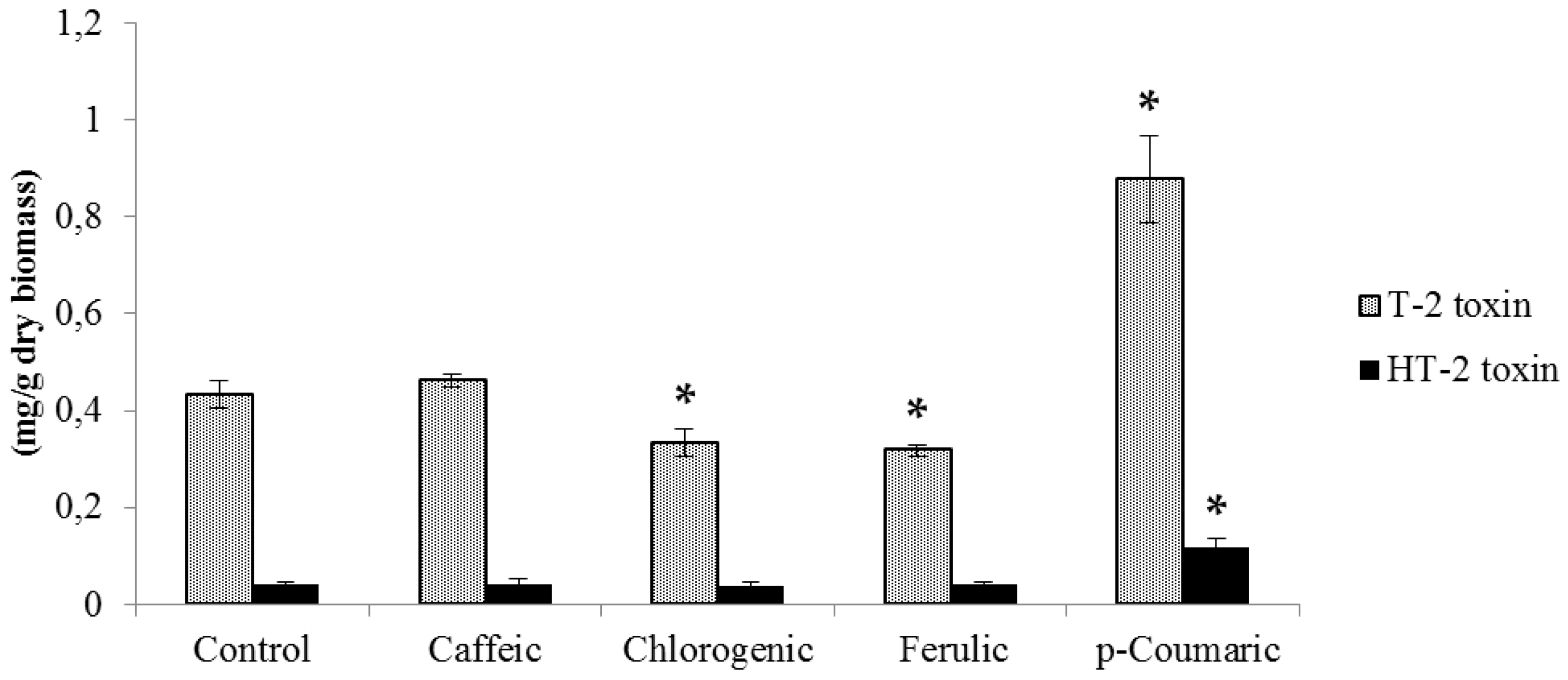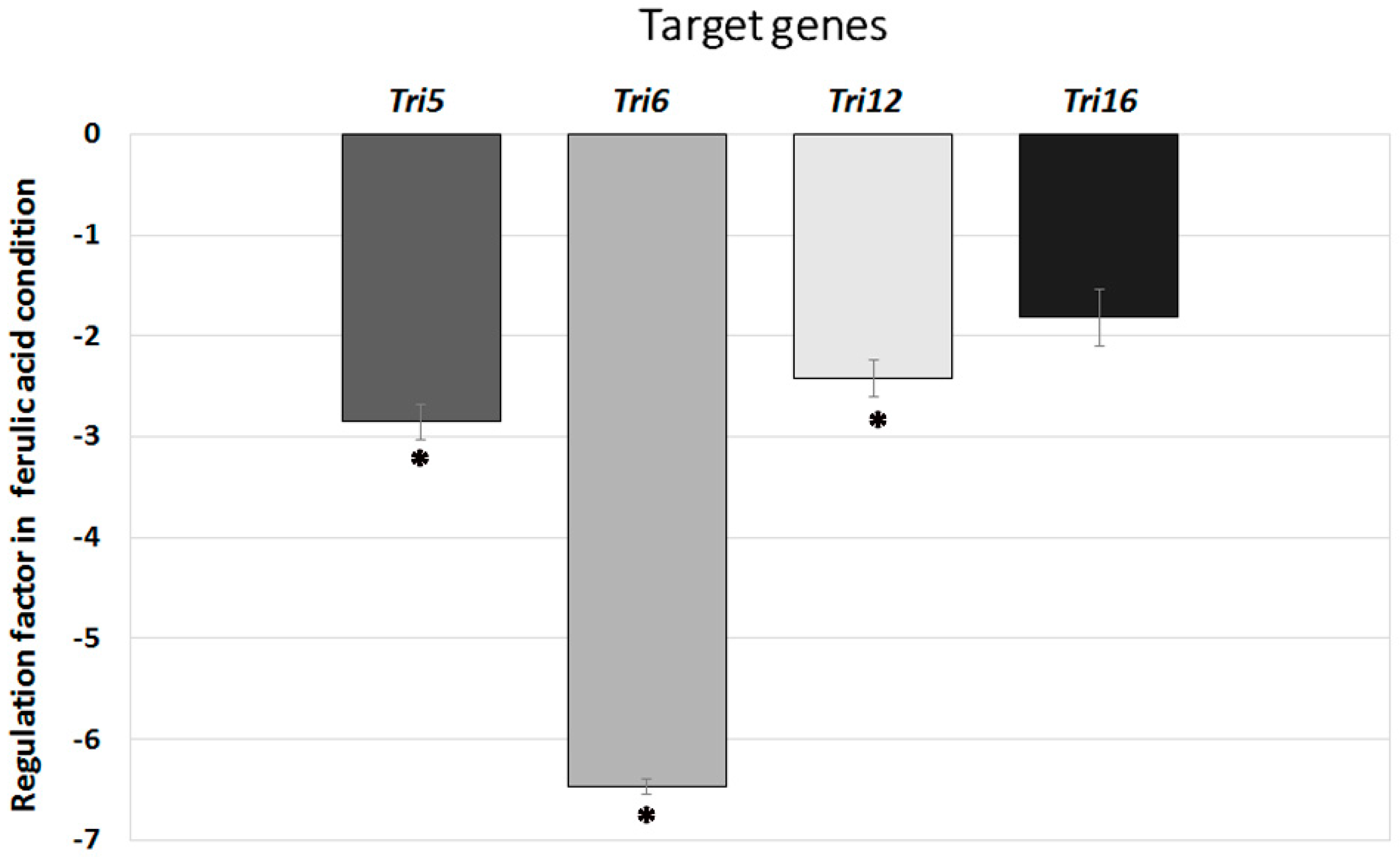Effects of Phenolic Acids on the Growth and Production of T‐2 and HT‐2 Toxins by Fusarium langsethiae and F. sporotrichioides
Abstract
:1. Introduction
2. Results
2.1. Effect of Phenolic Acids on Fungal Growth
2.2. Effect of Phenolic Acids on the Production of T-2 and HT-2 by Fusarium Strains
2.3. Effect of Ferulic Acid on Tri Gene Expression by F. langsethiae
3. Discussion
4. Materials and Methods
4.1. Materials
4.2. Spore Suspension of Fusarium Strains
4.3. Antifungal Activity Assay
4.4. Extraction of Total RNA, Preparation of cDNA and RT-PCR Analysis
4.5. Analysis of T-2 and HT-2 Toxins by HPLC-MS/MS
4.6. Analysis of Phenolic Acids by HPLC-DAD
4.7. Statistical Analysis
5. Conclusions
Acknowledgments
Author Contributions
Conflicts of Interest
References
- Kokkonen, M.; Medina, A.; Magan, N. Comparative study of water and temperature relations of growth and T-2/HT-2 toxin production by strains of Fusarium sporotrichioides and Fusarium langsethiae. World Mycotoxin J. 2012, 5, 365–372. [Google Scholar] [CrossRef]
- Nazari, L.; Pattori, E.; Terzi, V.; Morcia, C.; Rossi, V. Influence of temperature on infection, growth, and mycotoxin production by Fusarium langsethiae and F. sporotrichioides in durum wheat. Food Microbiol. 2014, 39, 19–26. [Google Scholar] [CrossRef] [PubMed]
- Medina, A.; Magan, N. Comparisons of water activity and temperature impacts on growth of Fusarium langsethiae strains from northern Europe on oat-based media. Int. J. Food Microbiol. 2010, 142, 365–369. [Google Scholar] [CrossRef] [PubMed] [Green Version]
- Edwards, S.G.; Imathiu, S.M.; Ray, R.V.; Back, M.; Hare, M.C. Molecular studies to identify the Fusarium species responsible for HT-2 and T-2 mycotoxins in UK oats. Int. J. Food Microbiol. 2012, 156, 168–175. [Google Scholar] [CrossRef] [PubMed]
- Lindblad, M.; Gidlund, A.; Sulyok, M.; Börjesson, T.; Krska, R.; Olsen, M.; Fredlund, E. Deoxynivalenol and other selected Fusarium toxins in Swedish wheat - occurrence and correlation to specific Fusarium species. Int. J. Food Microbiol. 2013, 167, 284–291. [Google Scholar] [CrossRef] [PubMed]
- Mateo, E.V.; Valle-Algarra, F.M.; Mateo, R.; Jiménez, M.; Magan, N. Effect of fenpropimorph, prochloraz and tebuconazole on growth and production of T-2 and HT-2 toxins by Fusarium langsethiae in oat-based medium. Int. J. Food Microbiol. 2011, 151, 289–298. [Google Scholar] [CrossRef] [PubMed] [Green Version]
- De Angelis, E.; Monaci, L.; Mackie, A.; Salt, L.; Visconti, A. Bioaccessibility of T-2 and HT-2 toxins in mycotoxin contaminated bread models submitted to in vitro human digestion. Innov. Food Sci. Emerg. 2014, 22, 248–256. [Google Scholar] [CrossRef]
- EFSA (European Food Safety Authority). Scientific opinion on the risks for animal and public health related to the presence of T-2 and HT-2 toxin in food and feed. EFSA panel on contaminants in the food chain. EFSA J. 2011, 9, 2481. [Google Scholar]
- Peraica, M.; Rašić, D. Review. The impact of mycotoxicoses on human history. Arh. Hig. Rada Toksiko. 2012, 63, 513–518. [Google Scholar] [CrossRef] [PubMed]
- Commission Recommendation 2013/165/EU (OJ L91, p12, 03/04/2013) of 27 March 2013 on the Presence of T-2 and HT-2 Toxins in Cereals and Cereal Products.
- Ferrochio, L.; Cendoya, E.; Farnochi, M.C.; Massad, W.; Ramírez, M.L. Evaluation of ability of ferulic acid to control growth and fumonisin production of Fusarium verticillioides and Fusarium proliferatum on maize based media. Int. J. Food Microbiol. 2013, 167, 215–220. [Google Scholar] [CrossRef] [PubMed]
- McKeehen, J.D.; Busch, R.H.; Fulcher, R.G. Evaluation of wheat (Triticum aestivum L.) phenolic acids during grain development and their contribution to Fusarium resistance. J. Agric. Food Chem. 1999, 47, 1476–1482. [Google Scholar] [CrossRef] [PubMed]
- Bily, A.C.; Reid, L.M.; Taylor, J.H.; Johnston, D.; Malouin, C.; Burt, A.J.; Bakan, B.; Regnault-Roger, C.; Pauls, K.P.; Arnason, J.T.; et al. Dehydrodimers of ferulic acid in maize grain pericarp and aleurone: resistance factors to Fusarium graminearum. Phytopathology 2003, 93, 712–719. [Google Scholar] [CrossRef] [PubMed]
- Samapundo, S.; De Meulenaer, B.; Osei-Nimoh, D.; Lamboni, Y.; Debevere, J.; Devlieghere, F. Can phenolic compounds be used for the protection of corn fungal invasion and mycotoxin contamination during storage? Food Microbiol. 2007, 24, 465–473. [Google Scholar] [CrossRef] [PubMed]
- Coma, V.; Portes, E.; Gardrat, C.; Richard-Forget, F.; Castellan, A. In vitro inhibitory effect of tetrahydrocurcuminoids on Fusarium proliferatum growth and fumonisin B1 biosynthesis. Food Addit. Contam. 2011, 2, 218–225. [Google Scholar] [CrossRef] [PubMed]
- Ponts, N.; Pinsons-Gadais, L.; Boutigny, A.L.; Barreau, C.; Richard-Forget, F. Cinnamic-derived acids significantly affect Fusarium graminearum growth and in vitro synthesis of type B trichothecenes. Phytopathology 2011, 101, 929–934. [Google Scholar] [CrossRef] [PubMed]
- Nesci, A.; Etcheverry, M. Effect of natural maize phytochemicals on Aspergillus section Flavi sclerotia characteristics under different conditions of growth media and water potential. Fungal Ecol. 2009, 2, 44–51. [Google Scholar] [CrossRef]
- Bakan, B.; Bily, A.C.; Melcion, D.; Cahagnier, B.; Regnault-Roger, C.; Philogène, B.J.; Richard-Molard, D. Possible role of plant phenolics in the production of trichothecenes by Fusarium graminearum strains on different fractions of maize kernels. J. Agric. Food Chem. 2003, 51, 2826–2831. [Google Scholar] [CrossRef] [PubMed]
- Boutigny, A.L.; Barreau, C.; Atanasova-Pénichon, V.; Verdal-Bonnin, M.N.; Pinson-Gadais, L.; Richard-Forget, F. Ferulic acid, and efficient inhibitor of type B trichothecene biosynthesis and Tri gene expression in Fusarium liquid cultures. Mycol. Res. 2009, 3, 746–753. [Google Scholar] [CrossRef] [PubMed]
- Boutigny, A.L.; Atanasova-Pénichon, V.; Benet, M.; Barreau, C.; Richard-Forget, F. Natural phenolic acids from wheat bran inhibit Fusarium culmorum trichothecene biosynthesis in vitro by repressing Tri gene expression. Eur. J. Plant Pathol. 2010, 127, 275–286. [Google Scholar] [CrossRef]
- Picot, A.; Atanasova-Pénichon, V.; Pons, S.; Marchegay, G.; Barreau, C.; Pinson-Gadais, L.; Roucolle, J.; Daveau, F.; Caron, D.; Richard-Forget, F. Maize kernel antioxidants and their potential involvement in Fusarium ear rot resistance. J. Agric. Food Chem. 2013, 61, 3389–3395. [Google Scholar] [CrossRef] [PubMed]
- Kimura, M.; Tokai, T.; Takahashi-Ando, N.; Ohsato, S.; Fujimura, M. Molecular and genetic studies of Fusarium trichothecene biosynthesis: Pathways, genes, and evolution. Biosci. Biotechnol. Biochem. 2007, 71, 2105–2123. [Google Scholar] [CrossRef] [PubMed]
- McCormick, S.P.; Stanley, A.M.; Stover, N.A.; Alexander, N.J. Trichothecenes: From simple to complex mycotoxins. Toxins 2011, 3, 802–814. [Google Scholar] [CrossRef] [PubMed]
- Mateo, E.M.; Valle-Algarra, F.M.; Jiménez, M.; Magan, N. Impact of three sterol-biosynthesis inhibitors on growth of Fusarium langsethiae and on T-2 and HT-2 toxin production in oat grain under different ecological conditions. Food Control 2013, 34, 521–529. [Google Scholar] [CrossRef]
- Medina, A.; Magan, N. Temperature and water activity effects on production of T-2 and HT-2 by Fusarium langsethiae strains from north European countries. Food Microbiol. 2011, 28, 392–398. [Google Scholar] [CrossRef] [PubMed] [Green Version]
- Mylona, K.; Magan, N. Fusarium langsethiae: Storage environment influences dry matter losses and T-2 and HT-2 toxin contamination of oats. J. Stored Prod. Res. 2011, 47, 321–327. [Google Scholar] [CrossRef]
- Kaushik, P.; Andújar, I.; Vilanova, S.; Plazas, M.; Gramazio, P.; Herraiz, F.J.; Brar, N.S.; Prohens, J. Breeding Vegetables with Increased Content in Bioactive Phenolic Acids. Molecules 2015, 20, 18464–18481. [Google Scholar] [CrossRef] [PubMed]
- Montibus, M.; Pinson-Gadais, L.; Richard-Forget, F.; Barreau, C.; Ponts, N. Coupling of transcriptional response to oxidative stress and secondary metabolism regulation in filamentous fungi. Crit. Rev. Microbiol. 2015, 41, 295–308. [Google Scholar] [CrossRef] [PubMed]
- Torres, A.; Ramírez, M.L.; Arroyo, M.; Chulze, S.; Magan, N. Potential for control of growth and fumonisin production by Fusarium verticillioides and F. proliferatum on irradiated maize grain using anti-oxidants. Int. J. Food Microbiol. 2003, 83, 319–324. [Google Scholar] [CrossRef]
- Dambolena, J.S.; Zygadlo, J.A.; Rubinstein, H.R. Antifumonisin activity of natural phenolic compounds. A structure- property-activity relationship study. Int. J. Food Microbiol. 2011, 145, 140–146. [Google Scholar] [CrossRef] [PubMed]
- Vogel, H.J. A convenient growth medium for Neurospora (Medium N). Microb. Gen. Bull. 1956, 13, 42–43. [Google Scholar]
- Sample Availability: Samples of the compounds are not available from the authors.




| Phenolic Acid | Dry Fungal Biomass (mg) | |
|---|---|---|
| F. langsethiae | F. sporotrichioides | |
| Control | 19.67 ± 0.70 | 28.83 ± 0.26 |
| Caffeic acid | 26.03 * ± 1.79 | 31.97 * ± 0.48 |
| Chlorogenic acid | 24.53 * ± 0.55 | 29.42 ± 0.43 |
| Ferulic acid | 24.27 * ± 1.42 | 33.74 * ± 1.16 |
| p-Coumaric acid | 19.63 ± 1.82 | 30.64 * ± 0.87 |
| Time (days) | Dry Fungal Biomass (mg) | |
|---|---|---|
| Control | Ferulic Acid | |
| 3 | 6.92 ± 1.49 | 5.07 ± 1.68 |
| 6 | 17.10 ± 1.21 | 14.51 * ± 0.71 |
| 10 | 22.29 ± 0.75 | 17.83 * ± 1.31 |
| 14 | 24.70 ± 0.49 | 21.11 * ± 0.65 |
| Gene | Accession No. Genbank | Forward Primer Sequence 5’–3’ | Reverse Primer Sequence 5’–3’ | PCR Efficiency |
|---|---|---|---|---|
| Β-tubulin | AF212817 | GGTAACCAAATCGGTGCTGCTTTC | GATTGACCGAAAACG AAGTTG | 1.97 |
| Citrate synthase | XM_011318922 | GGCTCACCGAGTTCAAGAAG | CTTCTCTTGGGCAAAAGTGC | 1.97 |
| Tri5 | AF449792.1 | CTATTCCTTGAGATTACAT | CCTTGTAGAATGACATAAGA | 2.00 |
| Tri6 | JXCE01000103.1; locus tag FLAG_12235 | CGCTTTCGAATATGGTGGTT | CCTACGGTGGAGCCTACAAA | 2.06 |
| Tri12 | JXCE01000103.1; locus tag FLAG_05858 | GGGCTTGCATATCTTGTGGT | TTCGGCCCTATTCGTACAAC | 1.88 |
| Tri16 | HQ594543.1 | GGTCTGGTCTAATCTTACA | CACGACATTACCCATATAAG | 2.02 |
© 2016 by the authors. Licensee MDPI, Basel, Switzerland. This article is an open access article distributed under the terms and conditions of the Creative Commons by Attribution (CC-BY) license ( http://creativecommons.org/licenses/by/4.0/).
Share and Cite
Ferruz, E.; Atanasova‐Pénichon, V.; Bonnin‐Verdal, M.; Marchegay, G.; Pinson‐Gadais, L.; Ducos, C.; Lorán, S.; Ariño, A.; Barreau, C.; Richard‐Forget, F. Effects of Phenolic Acids on the Growth and Production of T‐2 and HT‐2 Toxins by Fusarium langsethiae and F. sporotrichioides. Molecules 2016, 21, 449. https://doi.org/10.3390/molecules21040449
Ferruz E, Atanasova‐Pénichon V, Bonnin‐Verdal M, Marchegay G, Pinson‐Gadais L, Ducos C, Lorán S, Ariño A, Barreau C, Richard‐Forget F. Effects of Phenolic Acids on the Growth and Production of T‐2 and HT‐2 Toxins by Fusarium langsethiae and F. sporotrichioides. Molecules. 2016; 21(4):449. https://doi.org/10.3390/molecules21040449
Chicago/Turabian StyleFerruz, Elena, Vessela Atanasova‐Pénichon, Marie‐Noëlle Bonnin‐Verdal, Gisèle Marchegay, Laëtitia Pinson‐Gadais, Christine Ducos, Susana Lorán, Agustín Ariño, Christian Barreau, and Florence Richard‐Forget. 2016. "Effects of Phenolic Acids on the Growth and Production of T‐2 and HT‐2 Toxins by Fusarium langsethiae and F. sporotrichioides" Molecules 21, no. 4: 449. https://doi.org/10.3390/molecules21040449





